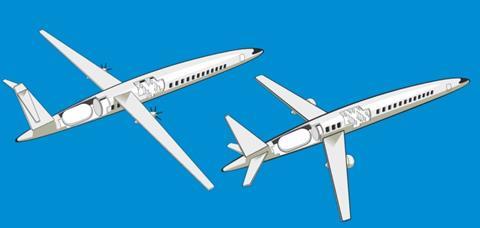Full adoption of liquid hydrogen-powered aircraft on all replaceable routes by 2050 would cap passenger aviation emissions at 2035 levels, but not reduce them, according to analysis released by the US-based non-profit International Council on Clean Transportation.
Its white paper stresses that this is based on the “most optimistic” fuel and fleet-turnover assumptions, and 100% adoption would represent a “radical case” – adding that “realistic” adoption rates would be around 20-40%.
The organisation’s analysis models the performance of potential 70-seat turboprop and 165-seat narrowbody designs, with liquid hydrogen tanks in the fuselage, indicating they could respectively operate on ranges up to 760nm (1,400km) and 1,830nm (3,400km).
Liquid-hydrogen turboprops could replace “nearly all” current turboprop operations, it states, but these only amount to a small fraction of passenger transport.
It recommends that manufacturers focus on narrowbody designs to provide the highest potential emissions coverage, given the extent to which such aircraft account for passenger traffic.
“While liquid hydrogen-powered narrowbody aircraft cannot completely replace [the] fossil-fuelled alternative, they could cover almost two-thirds of the narrowbody market,” the analysis says, adding that this translates to one-third of the total passenger aviation market.

With the 20-40% rate of introduction, liquid hydrogen-powered aircraft designs could mitigate 126-251 million tonnes of carbon dioxide by 2050, about 6-12% of the passenger aviation inventory for that year.
The analysis claims 100% adoption would increase this to 628 million tonnes but still only amount to 31% of the inventory – although this mitigation would be sufficient to cap emissions at 2035 level.
“Other technologies, including more fuel-efficient aircraft and sustainable aviation fuels, along with measures to moderate traffic growth, will be needed to meet airlines’ aggressive climate goals,” it says.
Evolutionary aircraft propelled with liquid-hydrogen combustion, it states, “do not perform as well” as jet-fuel counterparts, being more energy-intensive with payload and range limitations, but could “still play an important role” in decarbonising aviation.
Fuelling with ‘green’ hydrogen – whereby fuel production has near-zero emissions – will cost more than fossil jet fuel, requiring ‘carbon pricing’ to close the gap, but less than using ‘blue’ hydrogen, derived from fossil fuel, or synthetic drop-in e-kerosene.
Although better fuel efficiency from fleet modernisation and operational changes will reduce emissions more than switching fuels, the speed of air traffic development is outpacing these improvements.
“While important, fuel efficiency alone will not be enough for airlines to meet their climate protection goals,” the analysis says. “The heavy lifting in reducing the climate impact of aviation will need to come from fuel switching.”


























